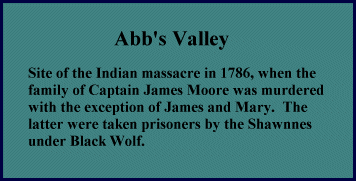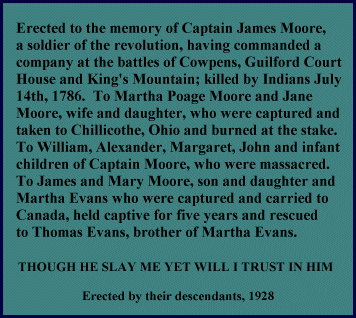ABB'S VALLEY MASSACRE
In western Virginia, in the northeastern corner of Tazewll County, lies Abb's Valley. In the small mountain village of Boissevain, is the Moore Monument.

The opposite side of the monument reads:

The monument was erected on the Moore homestead, where Capt. James Moore fell to the marauding Indians.
Our story actually begins in 1784, when in September of that year Capt. Moore's fourteen year-old son, James, was captured by Shawnee Indians led by Black Wolf. The Shawnee had been allies of the British during the Revolutionary War. Although the war ended in 1783, the Shawnee were still raiding American settlers along the Shenandoah Valley.
Nearly two years after young James' capture, in June 1786, Black Wolf returned to Abb's Valley with thirty to fourty warriors . In the morning dawn of July 14, Black Wolf and his warriors attacked the Moore home.
Captain James Moore was in the field giving salt to his horses. His children Willam and Rebecca were fetching water. Mary Moore was at the fence, which enclosed the yard, signaling the reapers (William Clark and Irish John) that breakfast was ready. The other children were in the house, except for Joseph, who was staying with his maternal grandparetns while recovering from the measles, and Alexander who was doing his chores. Also in the household at the time was Martha Evans, a young woman who was visiting, and John Simpson, an Englishman who was sick in the loft of the house.
When the Indians attacked Mary ran into the house and the family began closing the doors and windows, and in the confusion locked out James Moore. James made it to the fence before 7 rifle balls brought him down. He was finished off with a tomahawk and scalped. William and Rebecca, who had gone for water, were overtaken and killed, and Alexander was killed as he was trying to make it back to the house. Two dogs tried valiantly to protect the family, but one was killed and the other subdued.
Mary Evans went to the loft to take John Simpson a gun, but found him dead at the window. She returned down stairs and hid under a plank in the floor. The Indians cut through the door, entered the house, took the family captive and began looting the house. In the meantime, the reapers ran for help and to warn others at the Bluestone Settlement some six miles or more distant.
While the Indians were pilfering the house, Martha Evans escaped from her hiding place and hid in a ravine. She would have been safe, but as the Indians were preparing to leave, one Indian sat on a log above her to work on his gun and supposing she had been discoved and was about to be shot she made herself known and was also taken captive.
The Shawnee returned to their homeland with their captives in what is now Ohio, near Chillicothe. On the long trip back to Ohio two of the Moore children were killed, John the first day out, and the baby, Margaret, later had her head bashed against a tree. This left Martha, her two daughters, Jane and Mary, and Martha Evans.
Later, Mary Moore and Martha Evans were taken to another village, while Martha Moore and her daughter, Jane were kept at the village near Chillicothe when Cherokee Indians were approaching. The Shawnee women heard that they wanted to kill the white captives and so the women were separated.
The Cherokee Indians tortured Martha Moore and her daughter, Jane, and they were then burned at the stake. Martha, and probably Jane, had been tortured for three days with wood splinters which were fired. An old Shawnee woman, taking pitty on Martha, ended her suffering with a quick blow from a tomahawk. A few days later Mary Moore and Martha Evans returned to the village where Mary learned the fate of her mother and sister.
After some time Mary was sold to Mr. Stogwell, or Stagwell, for a few gallons of rum and taken to Canada. Martha Evans was purchased by a Mr. Caldwell who treated her badly and eventually was passed on to the family of a Mr. Donaldson, a wealthy Englishman.
Young James Moore had been sold by the Shawnee to a French trader named Bateeste Ariome for $50, who took him to Canada, near Detroit and treated him as a son. James arranged for a letter to be sent to his father informing him of his captivity and purchase by the French trader. When Capt. James Moore heard what happened to his son, he decided to leave him with the French trader, since he could not go after him and leave his family without his protection.
In later years James related his tale, he said, "Mr. and Mrs. Ariome were parents to me indeed. They treated me like one of their own sons. I ate at their table, and slept with their sons, in a good feather bed. They always gave me good counsel, and advised me not to abandon the idea of returning to my friends. I worked on the farm with his sons, and occasionally assisted him in his trading expeditions. We traded at different places, and sometimes went a considerable distance in the country."
James also related an encounter he had with four young Indians while on a trading trip with Mr. Ariome: "...four young Indians began to boast of their bravery and among other things, said that one Indian could whip four white men. This provoked me, and I told them that I could whip all four of them. They immediately attacked me, but Mr. Ariome, hearing the noise, came and took me away. This I considered a kind providence; for the Indians are very unskilled in boxing and in this manner of fighting, I could easily have whipped all of them; but when they began to find themselves worsted, I expected them to attack me with clubs, or some other weapon, and if so, had laid my plans to kill them all with a knife, which I had concealed in my belt, mount a fleet horse, which was close at hand, and escape to Detroit."
We have young James' account of his learning the fate of his sister, Mary and Martha Evans: It was while on a trading expedition that..."I first head of the destruction of my father's family. This I learned through a Shawnee Indian, with whom I became acquainted when I lived with them, and who was one of the party on that occasion. I received this information sometime in the summer after it occurred. In the following winter, I learned that my sister Polly (Mary) had been purchased by a Mr. Stagwell, an American by birth, but unfriendly to the American cause. He was a man of bad character - an unfeeling wretch - and treated my sister with great unkindness. At the time he resided a considerable distance from me. When I heard of my sister, I immediately prepared to go and see her; but as it was then in the dead of winter, and the journey would have been attended with great difficulties, and on being told that Mr. Stagwell intended to move to the town where I resided in the following spring, I declined it. When I heard that Mr. Stagwell had moved, as was contemplated, I immediately went to see her. I found her in the most abject condition, almost naked, being clothed only with a few dirty and tattered rags, exhibiting to my mind, an object of pity indeed. It is impossible to describe my feelings on the occasion; sorrow and joy were both combined; and I have no doubt the feelings of my sister were similar to my own. On being advised, I applied to the Commanding Officer at Detroit, informing him of her treatment, with the hope of effecting her release. I went to Mr. Simon Girty, and to Colonel McKee, the Superintendent of the Indians, who had Mr. Stagwell brought to trial to answer to the complaint against him. But I failed to procure her release."
In the mean time, Martha Evans had gotten word to her family, and her brother, Thomas, came to the rescue. With the aid of Thomas, Mary and Martha were freed, and along with James, the four set out for home.
James' narrative continues, "All being now at liberty, we made preparations for our journey to our distant friends, and set out, I think, sometime in the month of October, 1789; it being a little more than five years from the time of my captivity, and a little more than three years after the captivity of my sister and Martha Evans. A trading boat coming down the lakes, we obtained a passage, for myself and sister, to the Moravian Towns, a distance about two hundred miles, and on the route to Pittsburg. There, according to appointment, we met with Mr. (Thomas) Evans and his sister (Martha), the day after our arrival. He had, in the meantime procured three horsee, and we immediately set out for Pittsburg. Fortunately for us, a party of friendly Indians, from these towns, were about starting on a hunting excursion, and accompanied us for a considerable distance on our route, which was through a wilderness, and the hunting ground of an unfriednly tribe. On one of the nights, during our journey, we encamped near a large party of these unfriendly Indians. The next morning four or five of their warriors, painted red, came into our camp. This much alarmed us. They made many inquiries, bud did not molest us, which might have been the case if we had not been in company with other Indians. After this nothing occurred worthy of notice until we reached Pittsburg. Probably we would have reached Rockbridge (county) that fall if Mr. Evans had not, unfortunately, got his shoulder dislocted. In consequence of this, we remained until the spring with an uncle of his, in the vicinity of Pittsburg. Having expended nearly all of his money in traveling, and with the physician, he left his sister and proceeded on with sister Polly and myself, to the house of our uncle, William McPhaetus, about ten miles wouthwest of Staunton, near the Middle River. He (Thomas Evans) received from Uncle Joseph Moore, the administrator of father's estate, compensation for his services, and afterword returned and brought in his sister."
Mary Moore lived two or three years with her grandmother, Jane Poage in Rockbridge County, Virginia and later lived in the home of Joseph Walker, who had married her father's sister.
In 1798 Mary married Samuel Brown. Samuel built a large cradle for Mary to rock her to sleep whenever she had terible nightmares. The cradle is on display at the Rockbridge Historical Society Headquarters.
This page Hosted by Get your own